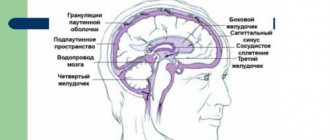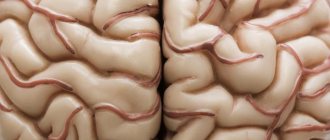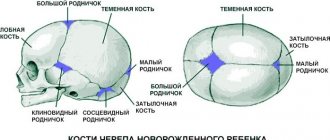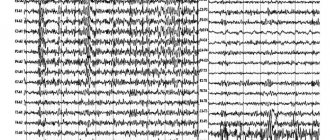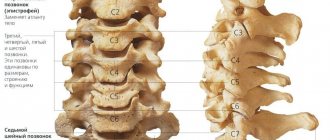Interhemispheric asymmetry: learning problems in normal and pathological conditions
The problem of interhemispheric asymmetries is one of the most pressing problems of our time. The study of hemispheric asymmetry plays a big role in solving problems in education. This is due to the fact that in educational institutions it is important to take into account the individual characteristics of each child, including the dominant hemisphere. Various sciences of the modern world study the brain and penetrate into the problem of interhemispheric asymmetry of the brain.
Each person can have a dominant hemisphere. Identifying the dominant hemisphere is important for every person to know, because this will further affect his socialization, learning, development and will help to understand his abilities. Knowledge of hemispheric dominance is also very important psychologically. Focusing on the dominant hemisphere, a psychologist, speech therapist and teacher can use special methods to correct or teach a child, which will help the child cope with the task more easily [7].
Since ancient times, people have clearly delineated the circle of “us” and “strangers”. Guided by the herd spirit inherent in the human psyche, people at all times united into groups, associations, societies. At first, these were very primitive signs, for example, a person’s belonging to a certain clan. But time passed and as society and man himself developed, the signs became more and more sophisticated.
A person with right-hemisphere asymmetry of the brain, that is, a left-hander, cannot go unnoticed in a society of right-handers. He perceives information, thinks, and performs everyday actions in a completely different way than left-hemisphere or right-handed people, which reveals his special organization of the psyche. The combination of indicators of functional, sensory and motor asymmetries provides a complete picture in determining the individual lateral profile of a particular individual. Based on this, in modern scientific society there are 3 types of brain organization: left hemisphere, right hemisphere and equal hemisphere types [1]. I would like to dwell in detail on the first two, as the most common types of brain organization.
According to statistics, the proportion of the population with right-hemisphere brain asymmetry is not so small and amounts to about 15% of the world's population. But despite this, left-handed people always feel a kind of pressure from society. In childhood, many parents zealously try, at all costs, to retrain the “unhappy” baby, making him a “normal” right-hander. When a child grows up, he will constantly feel interested glances in his direction, and sometimes a rather negative attitude towards his mental characteristics. Unfortunately, due to the lack of sufficient information among citizens, sometimes absolutely ridiculous ideas arise about left-handers as “strangers” to our society, some even attribute mental disorders to them. In fact, right-hemisphere asymmetry of the brain, of course, does not necessarily mean that an individual has deviations from the norm of development, but only creates differences in the cognitive processes of left-handers and right-handers [5].
In a person with a left-hemisphere type of brain organization, the left hemisphere acts as the dominant hemisphere. Such an individual has a tendency to generalize and abstract, and cognitive processes are predominantly verbal and logical in nature. It is the left hemisphere that is designed to carry out operations with symbols, conventional signs and words, which makes it possible to conclude that there are conceptual and abstract types of thinking. A feature of right-handed thinking is the presence of so-called elements of unambiguous context. Left-hemisphere individuals, when organizing material of a symbolic nature, create a text that is strictly unambiguously understood, without the possibility of its interpretation and explanation in other ways. In other words, we can conclude that there is a rather pedantic and one-sided approach to understanding statements in the process of interaction in society. The obvious advantages of right-handed people include their keen sense of duty to the promise they made; they are efficient, responsible, reasonable, rational and principled. Also, individuals of the left-hemisphere type are characterized by a large amount of memory, and the speech of such people is devoid of agrammatisms. But also in their character there are such features as: insufficient manifestation of flexibility, spontaneity, spontaneity. They are used to keeping everything to themselves, not letting their true experiences and emotions out, so they may seem somewhat secretive. Based on the structure of the left-hemisphere asymmetry of the brain, right-handed people are suitable for such professions as: linguist, engineer, philosopher, mathematician. They can also be not only representatives of theoretical disciplines, but also administrative positions [2].
People with a right-hemisphere type of brain organization also have their own characteristic features. To these we can include, for example, not the verbal-logical nature of cognitive processes, but the concrete-figurative one. In addition, left-handers are characterized by the presence of a divergent type of thinking. Such people, as a rule, do not think in a standard way; for them there are no frameworks or restrictions; they see many different options and ways to solve them in solving any problem, unlike narrow-minded right-handers. The right hemisphere of the brain is responsible for orientation in space, operations with images of real and specific objects, and also easily perceives spatial connections between objects. Left-handers have visual-figurative thinking, which helps them see the situation as a whole and predict the changes that this or that action will lead to in relation to a given situation. The right hemisphere of the brain, continuously regulating subconscious processes and control over involuntary behavior, produces spatial and structured transformations of information, assesses the complexity and symmetry of an object. The right-hemisphere type of brain organization gives an individual the opportunity to look deeper into what is happening, helping to see not only the object in front of him, but also the background behind it, to deal not with the center, but with the periphery. Thus, the right hemisphere ensures an even distribution of attention, rather than focusing and concentration. Being an organ of the human unconscious, the right hemisphere makes it possible to simultaneously recognize and analyze a large number of connections, sometimes quite contradictory from a logical point of view. People with right-hemisphere asymmetry use in life more intuitive instincts and emotional impulses than strict and logical arguments. The advantage of this type of thinking is manifested in situations that involve complex information that has a large number of internal contradictions and which at first glance cannot be reduced to an unambiguous meaning. Situations of this nature are a creative process. Left-handers, as a rule, have quite expressively colored speech, rich in gestures and intonations. Such people definitely cannot be called boring and monotonous speaking. Despite the fact that their speech is not structured, confusion, hesitation, as well as unnecessary words and sounds are possible, left-handed people have emotional and rich speech. It is about this category of people that they say with admiration: “He’s tongue-tied!” Left-handers are holistic, creative people, capable of openly expressing feelings. They are open to the world, naive and trusting, sociable and sociable. The right-hemisphere type of organization is also characterized by the ability to subtly feel and experience difficult life situations, to easily become upset and cry, or to become angry, that is, to act according to one’s mood. That is why among left-handers you can find a large number of journalists, writers, organizers and cultural figures [8].
Having identified and analyzed the characteristics of the psyche and the nature of the cognitive processes of left- and right-hemisphere people, we can conclude that different approaches are necessary in the process of mastering the school curriculum. Any learning process begins with a properly built motivation of the child to gain knowledge and further learning itself. An important component in achieving this is the interest of the child, the creation of conditions that will demonstrate to him that the educational process is not a routine and boring phenomenon. Thus, knowing the peculiarities of the thinking of right-hemisphere children, we will place emphasis in their teaching on the aesthetic side of objects. For left-handers, there is a great need for self-realization, getting the highest score and praise from the teacher. On the contrary, the left-hemisphere type of thinking is characterized by an orientation towards the cognitive side of the educational process. They are attracted not by praise, but directly by the acquisition of new knowledge and its depth. School activities themselves are considered by right-handers as a way of self-improvement, development of volitional qualities and thinking. For them, it is not the teacher’s assessment that is important, but the learning result itself. In addition, in the process of mastering the school curriculum, it is important to separate children according to their sensory perception characteristics. So, you can conduct a simple test to determine this fact. It is necessary to trace in which direction the child turns his eyes in the process of thinking. Since cognitive activity primarily occurs in one of the cerebral hemispheres, triggering eye movement, it can be assumed that left-hemisphere children will move their eyes to the right, and right-hemisphere children will move their eyes to the left. For left-hemisphere children, the right hemisphere of the classroom space will be significant for perception, so it is necessary to seat such a child in such a way that the board and teacher are on his right side. For right-hemisphere children, the same principle will apply by analogy, but with the replacement of the side of the class hemisphere [9].
An important feature is the process of processing information during a lesson, which occurs differently in left- and right-hemisphere children. Left-brained students may often be called "slow-brained" in the classroom due to their slow processing of information. They slowly and thoughtfully savor every detail; they are not characterized by working on the “question-instant answer” principle. Right-hemisphere children, on the contrary, process information almost instantly, but spontaneously and chaotically. Teachers call such students “in a hurry.”
The speech aspect of the educational process reveals some problems in the use of speech by right- and left-hemisphere children. Students with a dominant right hemisphere are characterized by a weak level of self-control in performing actions. That is why right-hemisphere students have poorly developed control over their pronunciation speech, missing words and problems in word selection and grammar are possible. On the contrary, children with a dominant left hemisphere have developed control over the pronunciation side of speech. Their weak point is summarizing. Problems may also arise with the development of fluent oral speech; it may be necessary to provide assistance in the development of cursive writing in a child. They are successful in applying rules and using words correctly in sentences [1].
We can also observe significant differences in the types of brain organization in the example of the memory process. For right-hemisphere students with visual memory, a characteristic feature is the visualization of information. Such children see words as if through the eyes of the brain. Children of the right hemisphere type have the phenomenon of “innate literacy.” Their fingers and eyes seem to write for them, knowing the correct spelling of a particular word. But, unfortunately, during the process of studying at school, the “innate literacy” of this category of children is destroyed. This is due to the use of an analytical approach to the study of literacy in the curriculum of general education institutions, which is not typical for right-brain students. A child with a dominant left hemisphere can be compared to a tape recorder. Due to the auditory type of memory present in the student, after receiving a question, he, as it were, plays the desired tape in his head. And then the child chooses a piece from it containing the correct answer. During the educational process, a left-hemisphere student often faces the problem of the need to translate remembered information into another modality. This occurs due to the tendency of teachers to change modality in the process of presenting lesson material and conducting an exam. In contrast to this problem, left-hemisphere children make excellent use of the characteristic features of their voluntary memory. Unlike right-hemisphere students, who memorize through practical activities and not through willpower, left-hemisphere children are prone to memorization. To remember, they need repeated repetition and memorization, which is used in the school curriculum [7].
It is also important to choose the right techniques and methods in the process of school teaching. To do this, it is necessary to take into account the peculiarities of thought processes characteristic of children with different types of functional asymmetry of the brain. Thus, it is important to remember the need for different approaches in the learning process using theoretical materials. Reading and evaluating words in a text by left-hemisphere children is comparable to an “attack.” That is why it is important for such students to use a discrete approach to learning, that is, an inductive path “from part to whole.” For right-hemisphere students, on the contrary, it is necessary to use the deductive path of learning “from the general to the specific.” It is for this reason that there are often problems in mastering the school curriculum by right-hemisphere children using the Zaitsev method or the Zankov system, since they are intended for the left-hemisphere type of brain organization [8].
The characteristics of a child’s individual lateral profile often determine the presence of age-related and gender-related manifestations of brain organization. If, for some reason, teachers and parents do not take into account these features of the functional organization of the brain, then this can lead to problems such as hyperactivity, school failure and deficiencies in speech function. The latter is one of the most important problems, since underdevelopment, delay or complete absence of speech will complicate schooling and the future socialization of the child.
When working with children with disabilities, and especially with hearing and speech impairment, one of the most important problems is diagnostic work with the child to predict the characteristics of his speech development. The solution to this problem lies in the analysis of the profile of functional asymmetry [4].
Studies conducted with children with general speech underdevelopment reveal many facts about the relationship between the child’s individual lateral profile and speech disorders. Thus, precisely among children with disabilities, the most common is the left profile of functional sensorimotor asymmetry, rather than the right one. Another interesting fact is that when analyzing children from the group with severe speech impairments, boys mostly have a mixed type of functional sensorimotor asymmetry, while girls have left or symmetrical profiles. If we analyze the intellectual abilities of children with special needs, we will come to an interesting conclusion. The fact is that the highest intelligence indicators are observed in the group of normatively developing boys, as well as boys with minor speech impairments. But at the same time, children from both groups necessarily have a left type of functional asymmetry. If we take a group of preschool children with more pronounced speech impairments, then we will observe the presence of the lowest intellectual indicators in boys with right and mixed types of functional asymmetry. In addition, the results of the study revealed that in groups of preschool children with less severe speech disorders there are approximately the same number of children with a left, right or symmetrical profile. But, if we analyze a group of preschool children with pronounced problems of speech development, then we will see the largest number of children with the left profile of functional sensorimotor asymmetry. Based on the above facts, we can assume that the presence of left profile in preschool children with severe speech impairments indicates paranatal influences on the child, which could lead to a decrease in the level of activity of the right hemisphere [6].
Features of the individual lateral profile, in addition to the speech aspect, leave an imprint on the intelligence and mental health of the child. Thus, according to a study conducted with children with normal development, mental retardation, and mental retardation, we can draw a conclusion about the specificity of the manifestation of brain asymmetry. Based on the percentage results, we see that the percentage of “pure right-handers” and right-handers in groups of children with mental retardation is 1.6-1.8% higher compared to the group of subjects with normal development. But, despite this, in general terms, the percentage of “pure right-handers” and right-handed children in groups of children with mental retardation and mental retardation is the lowest compared to the group with normal development, and ranges from 1.8% to 4% [3].
If we compare left-brain and right-brain people, we can conclude that these people adapt to the world differently using their abilities. The dominant hemisphere will help a person decide on his future profession and make his work activity less difficult. But a person must also develop the hemisphere that does not predominate in his life, because it will help him in various life situations and make a person more self-confident [5].
The dominant hemisphere is important to take into account, especially in the development of children. After all, their training and education depend on this. You can choose various methods and methods, taking into account the dominant hemisphere, which will help the child in further development and learning in kindergarten and school. As is known, school teaching methods mainly train and develop the left hemisphere, ignoring the development of the right hemisphere. With the help of differentiated learning, exploring the specifics of a child’s cognitive development and perception, it is possible to develop pedagogical methods and methods, taking into account the individual and psychophysiological characteristics of children.
Thus, we can conclude that it is necessary to timely determine the child’s individual lateral functional sensorimotor profile for his further successful education at school. After all, each child needs a purely individual approach, which can have a beneficial effect on his mental and mental development in the future.
How and why to develop interhemispheric interaction in children?
To develop interhemispheric connections, they resort to games and exercises that involve both the right and left hemispheres. The so-called “brain gymnastics” must be performed at least a few minutes a day. It will be useful for both children and adults.
Interaction is positively influenced by:
- kinesiological exercises;
- self-massage;
- didactic tasks;
- breathing exercises;
- listening to classical music;
- creative tasks;
- finger gymnastics;
- logorhythmics.
The more developed the interaction between the two hemispheres is in children, the easier it is for them to learn new things, build relationships with people, and achieve athletic heights.
Properties of brain asymmetry
Based on this example, it can be assumed that other functions also have a partial nature: dominance of one of the hemispheres is manifested in the development of hearing, manipulative function of the hands (preference for the right or left hand), etc. But this does not always happen. For example, visual perception does not require such pronounced lateralization of the cerebral cortex.
Functional asymmetry of the brain (FAM) contributes to a person’s better adaptation to reality: damage to one hemisphere can be compensated at the expense of the other.
According to modern data, FAM mechanisms affect not only mental functions, but also the functioning of the autonomic nervous system: for example, irritation of specific areas of the left hemisphere causes bradycardia and a drop in blood pressure, and the right hemisphere causes tachycardia and an increase in blood pressure.
However, such activation of the sympathetic and parasympathetic nervous system in natural conditions (for example, under stress) is aimed at optimizing cognitive processes. For example, energy metabolism necessary for certain cognitive activities must be maintained at a certain level due to the release of catecholamines into the blood, increasing blood pressure and heart rate.
Based on the above, we can distinguish three main properties that the functional asymmetry of the hemispheres has:
- Dominance of one hemisphere. It is assumed that zones of one are activated during any type of activity. This is a stable characteristic - especially in relation to speech and motor functions.
- Switchability. It implies a change in the activation of the hemisphere when the state of the body changes (illness, stress).
- Plastic. Cognitive abilities caused by asymmetry can change and become stronger during training or under the influence of various other factors.
Modern ideas also allow us to highlight:
- stationarity - in some areas of activity, the asymmetry of the cerebral cortex remains unchanged throughout life;
- dynamic - suggests that lateralization can occur over time and be measured by behavioral, physiological and biochemical methods.
Currently, an urgent task of studying such a phenomenon as functional asymmetry of the brain is to determine stationary and dynamic characteristics, their interaction under normal conditions and conditions of dysontogenesis (neuropsychic pathology).
Pathologies
The problems of interhemispheric brain asymmetry and interhemispheric interaction are studied by many doctors. In some diseases, there is a lack of interaction between the hemispheres. Smoothness of functional asymmetry and other deviations (deviations) are detected in patients with schizophrenia, epilepsy, and neurasthenia.
Aphasia (speech impairment) and agnosia (inability to recognize) develop due to damage to the structures of the left (dominant) hemisphere. Apraxia (the inability to perform purposeful movements) occurs as a result of damage to the left (dominant) hemisphere or corpus callosum.
Interhemispheric asymmetry determines a person’s individuality, his way of thinking, his abilities for creativity and a certain sport. Over the course of life, the degree of influence of a particular hemisphere on the processes of perception, speech and other activities may change. To stimulate the activity of a certain half of the brain, you need to make it work - perform special exercises.
700
Separation of functions
General ideas about interhemispheric asymmetry help to understand the issues of the formation of a person’s individuality and the specific type of higher nervous activity inherent in it. According to numerous studies, interhemispheric asymmetry is associated with the functional activity of the brain hemispheres. The left half of the head is responsible for states and processes:
- Purposeful actions.
- Understanding cause and effect relationships.
- Formation of an orderly context in which there are no contradictions and inconsistencies between elements.
- Logical thinking.
When concentrating attention, activating the process of verbal expression of thoughts and feelings, abstraction (a form of cognition that involves identifying the essential properties, features and connections of an object), the left half of the brain structures is activated.
The activity of the brain structures of the right hemisphere is aimed at ensuring the integrity of perception and behavior. The main function of the right half is to form a meaningful context, which ensures the integration of the individual in society. It is about communication skills in relation to other people with different personalities and behavioral patterns. The right side is responsible for processes and personality traits:
- Creative skills.
- Concrete-figurative thinking.
- Emotional activity.
The structures of the right half of the head are activated when an individual experiences emotions, feelings, and is engaged in creative activities. Insufficient functioning of the right hemisphere leads to social maladjustment and the development of mental and psychosomatic disorders. It should be taken into account that the specificity of the functions of the hemispheres is not absolute.
Interhemispheric coherent, correlating connections between the halves of the brain change during the process of mental activity. The interaction of brain structures of different parts of the head is affected by pathological foci that arise as a result of atrophic, ischemic, neurodegenerative changes and associated intracerebral changes. Regular training of the activity of a certain half of the brain provokes a change in the nature of the interaction of the hemispheres.
Numerous studies show that the functions of recognizing emotions and speech are regulated by both hemispheres. For example, the temporal lobe of the right hemisphere and the speech sections of the left hemisphere are responsible for understanding the emotional component of speech. If a person poorly recognizes the emotional components (intonation, shades, pitch of voice) of speech, during an EEG study, he has increased activity in the gamma range (reflecting cognitive processes) in the anterior regions of the left hemisphere.
Other clinical observations confirm the dependence of neurophysiological processes regulating verbal and mental activity on the bioelectrical interaction of the cortical structures of both hemispheres (especially the temporal and inferior frontal regions). Mutual integration of the results of the activity of brain structures in both halves of the head is necessary for the implementation of projects that require creativity.
The weakening of interhemispheric asymmetry of the brain is accompanied by an increase in verbal individuality and originality. The interaction of the halves of the brain during sleep, as one of the functional states, is ambiguous. The state when a person sees dreams (fast phase) is regulated by the left half of the brain. During the slow phase of sleep, the right half is activated.
